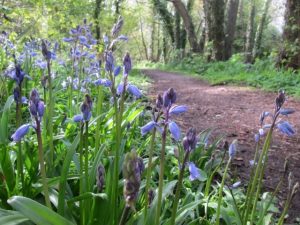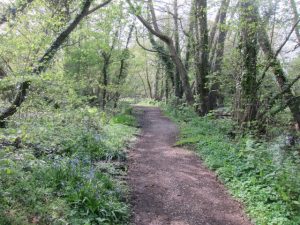
Afton Marsh Local Nature Reserve
The reserve covers 15.3 ha of tall fen and open water habitat, with broad-leaved woodland and scrub on the upper reaches of the Western Yar. The site is on the old flood plain of the river and was once grazing marsh. The River Yar flows northward from Freshwater Bay to Yarmouth, reaching the sea at a sluice gate on the Causeway. This closes at high tide causing the water to back up to the rustic bridge. Our site consists of the North and South Marsh – split in two by Blackbridge Road but linked by the river. The North Marsh is heavily wooded and the river is well defined. The South Marsh lies within the Isle of Wight Area of Outstanding Natural Beauty and consists of several watercourses, reeds and scrub. bordered by woodland. Weirs prevent water levels rising in the south marsh.
Our friend Colin Pope from the Isle of Wight Natural History and Archaeological Society has written a wonderful paper on the history of Freshwater marshes. Its well worth a read.
What to look and listen for …
There are several types of wetland habitat on the site providing a home for a variety of plants and animals. It is part of the Freshwater Marshes SSSI.
The river and the large pond in the North Marsh have areas of open water. The river is shaded along most of its length. In the open areas of the south marsh, bur-reed dominates the open water with fool’s watercress. The pond has been colonised by soft rush, toad rush, remote sedge and clumps of grey club rush. Breeding birds include mallard and moorhen. The dragonflies include southern hawker, emperor, broad-bodied chaser and common darter, and the damselflies include the large red, blue-tailed, common blue, and azure damselflies.
Woodland forms a thin strip along the eastern riverbank of the north marsh of the reserve. There is a dense scrub layer of hawthorn, hazel, and sallow. Osier woodland occurs on wet peaty soils to the north of Blackbridge Road. Silver birch woodland occurs in the north marsh on dry sandy soils, forming a screen around the pond. Birds seen and heard in the wooded areas include cuckoo, song thrush, blackcap, whitethroat, chiffchaff, long-tailed tit and green woodpecker.

In the South Marsh tall fen with common reed covers relatively large areas on deep, wet peat. In the wetter areas there is a varied flora with yellow loosestrife, marsh fern, marsh cinquefoil, greater bird’s-foot trefoil and marsh woundwort. Southern marsh orchid is found in wetter areas under recently cut scrub. In the drier areas, there is greater pond sedge together with meadowsweet, hemp agrimony, hemlock water dropwort, water mint, great willowherb and yellow flag. Breeding birds include reed warbler and sedge warbler. Butterflies include wall, small tortoiseshell, peacock, red admiral, orange tip and three species of whites -large, small and green-veined.
Alder woodland occurs on the south edge of the reserve, and has oak associated with the drier areas. The ground flora varies from mosses and liverworts, through greater tussock sedge and broad- leaved buckler fern to water mint, yellow flag and meadowsweet. Lesser water parsnip and marsh fern are also found here.
In the North Marsh listen to the wind in the trees; in the South Marsh it makes different noises in the willows and the reeds. Also listen for ducks hiding in the water plants on the Western Yar. In the South Marsh listen to the bees buzzing as they pollinate the flowers, to Sedge warblers and reed warblers breed in the Marsh, and early in the morning you may hear the boom of a bittern in the reeds.
… and smell and touch
Water mints has a lovely whiff, and in the South Marsh you can really smell the sea air. The marsh is full of grasses and sedges. How do you tell the difference? Remember sedges have edges.
Nature at home and activities on site
We have produced a super Colouring Sheet for you to download and complete at home. We have also produced an I Spy Sheet and Map for you to print at home, or download to your phone and take to the site. In addition our onsite interpretation board includes a self-guided sensory trail. And become a Bug Bunch Ranger. These are downloadable on site from the Information Pillar at the Afton Road entrance to the North Marsh and can also be accessed here.
Managing the site
The site is managed as a marsh, and so it is sometimes pretty wet. the animals and plants that live here depend on the water level being high at times. Dense willow scrub has invaded much of the reserve and an on-going management programme seeks to contain its spread and to open up some areas that have become heavily shaded to encourage reed and other more demanding wetland species.
How to get there
The site is at the end of the Yarmouth to Freshwater Bay cycle track following the old railway. There is currently no throughway for cyclists on the reserve. Access to the North Marsh is from Afton Road, close to Co-op.
Access to the South Marsh is from Coastguard Lane, or both marshes can be accessed from Blackbridge Road.

On foot and by bike – The site is at the end of the Yarmouth to Freshwater bay cycle track following the old railway. note, there is no throughway for cyclists on the reserve. The public footpath F36 runs along the west side of the south marsh from Blackbridge Road to Freshwater Bay and is open to the public at all times. There is also a permissive path running through the north marsh between Blackbridge Road to Afton Road, but this area is liable to flooding in wet weather and may be closed for safety reasons. The cycle racks are at the entrance to the South Marsh on Blackbridge Road.
By bus – Public Transport offers good access to the South Marsh with a seasonal bus stop along Afton Road for the Southern Vectis Needles Breezer, or year-round Freshwater Bay Route 12. For the North Marsh Route 7 and 12 ‘Co-op’ bus stop (note this Co-op has moved), or FYT Bus stops outside new Co-op building and is two minutes from entrance to reserve. (Bus Timetables)
By car – Park at Freshwater Bay and walk up Coastguard Lane (Sat Nav PO40 9QT). Or Park on Afton Road near Freshwater Co-op (Sat Nav PO40 9UH).
what3 words for North Marsh north entrance ///promising.fights.explain
what3 words for North Marsh south entrance ///begun.delusions.boost
what3 words for South Marsh north entrance ///sponge.workshops.shred
what3 words for South Marsh south entrance (not parking) ///yappy.toenail.disbanded
Access
In the South Marsh there are some steps, but the path is otherwise well surfaced but too narrow for mobility scooters in places.
In the North Marsh there is a narrow bridge with steps just north of Blackbridge Road. Most of the ground is fairly level. The site is mostly marsh and can be hard going when the ground is wet. There is open unfenced water. There is one seat within the marsh.
There is a Information Pillar at the Afton Road entrance to the North Marsh. The site information pillar has a QR code that links to an audible description detailed below. The information pillar also has a QR code that links to a map and activities. There is also a site map on the Information Pillar
There are no toilets on site. The nearest public toilets are in Freshwater Village.
We have written an Access Statement or this site. This includes mobility and sensory issues and opportunities. We welcome feedback from users.

We have produced an audible description creating a mind’s eye view of the area to allow a visually impaired person to enter with confidence. It will describe the entrance, the size of the area, where to find further information or help and any major obstacles or features. Information has been produced by visually impaired people ensuring it is useful and accurate. Access the description by scanning the QR code to the left of this text on your phone or tablet, or by clicking here.
Get Involved
There are various ways you can help improve and maintain our sites. We rely on volunteers to help with many tasks on our sites and also need people who are happy to regular visit the site be our “eyes and ears”, this means we can respond much quicker to issues. Our shop raises money to support our work and needs a team of volunteers. Or maybe you would like to help us with events. Find out more here.
You can also help by becoming one of our regular supporters. Even giving a few pounds each month can make a real difference, with your donation being invested into site management and improvement work to benefit site visitors and look after our precious wildlife. Sign up here.
